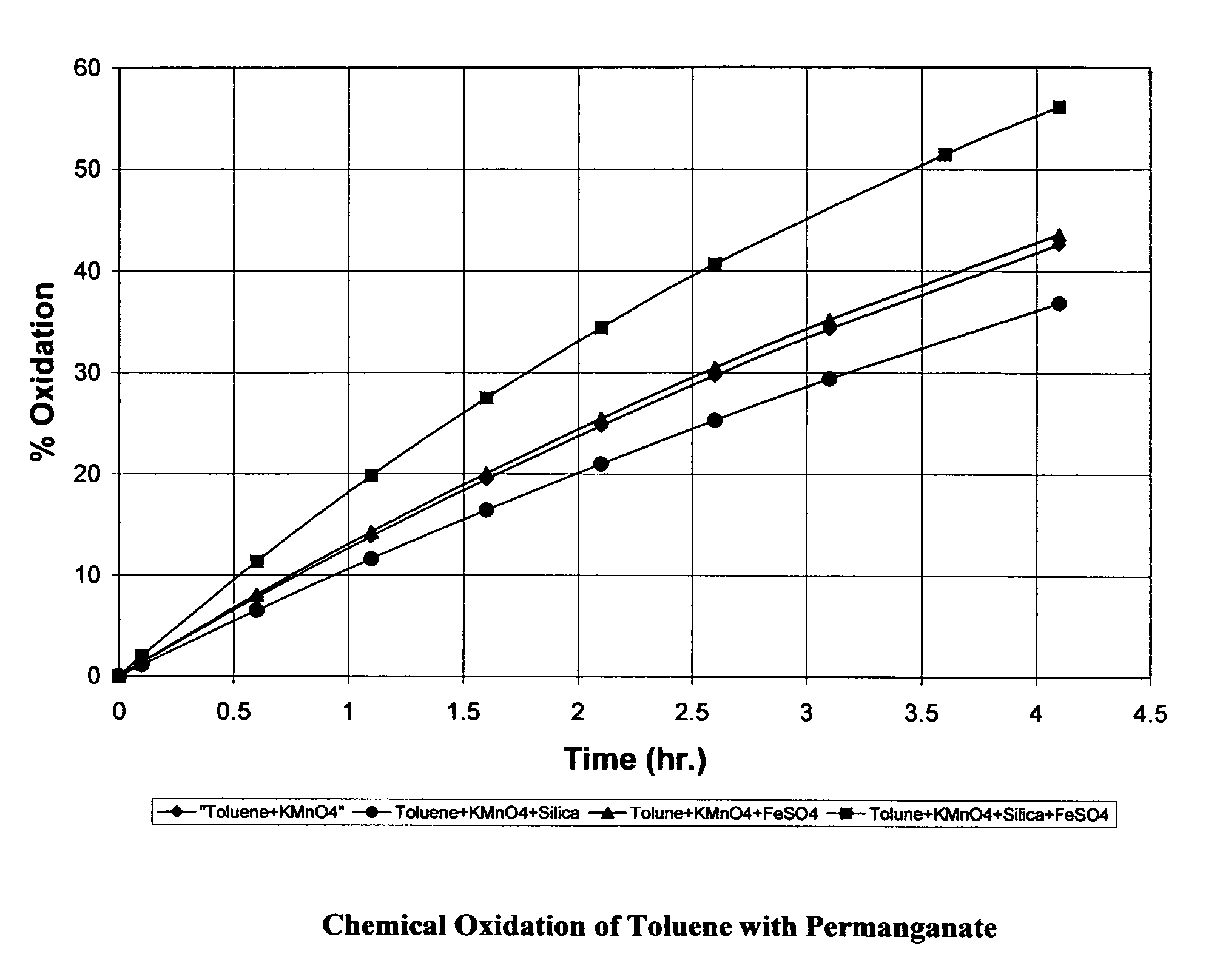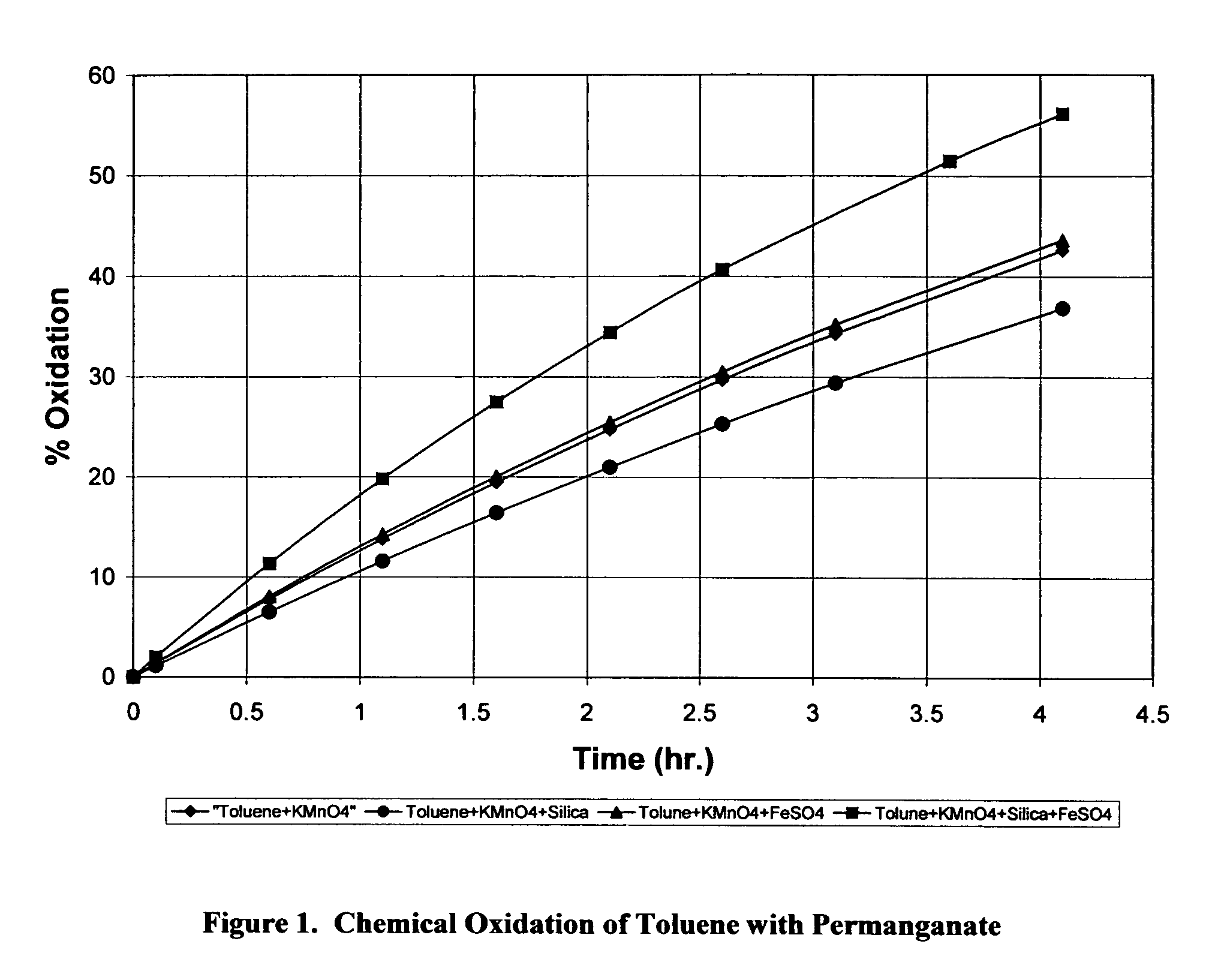Enhanced oxidation process for removal of water and soil contaminants
a technology of oxidation process and water and soil contaminants, which is applied in the direction of contaminated groundwater/leachate treatment, nuclear engineering, water/sewage treatment by oxidation, etc., can solve the problems of oxidation not proceeding to completion, injurious to microorganisms, and defeating the purpose of subsequent aerobic metabolism
- Summary
- Abstract
- Description
- Claims
- Application Information
AI Technical Summary
Benefits of technology
Problems solved by technology
Method used
Image
Examples
example a
Oxidation of Toluene by Potassium Permanganate
[0065] Solutions containing equal concentration of toluene (500 ppm) were made up in 100 ml of water. One of the four oxidant formula was added to one of the solutions. The four oxidant formulations used were: (a) potassium permanganate (3 g); (b) potassium permanganate (3 g) and silica (3 g), (c) potassium permanganate (3 g), ferrous sulfate (0.3 g).and (d) potassium permanganate (3 g), silica (3 g) and ferrous sulfate (0.3 g). The second solution was untreated and served as the control for the solutions treated by oxidant formulation, a, b, c, or d. Concentration of toluene in both solutions (treated solution and untreated control) was measured over time by gas chromatography. The reduction of the toluene concentration in the test solution was compared versus the concentration of the toluene in the control. The methodology used accounted for the potential loss of toluene by off-gassing from the control toluene solution.
example b
Oxidation of Toluene by Sodium Persulfate
[0066] Solutions containing equal concentration of toluene (500 ppm) were made up in 100 ml of water. One of the four oxidant formula was added to one of the solutions. The four oxidant formulations used were: (a) sodium persulfate (3 g); (b) sodium persulfate (3 g) and silica (3 g), (c) sodium persulfate (3 g), ferrous sulfate (0.3 g).and (d) sodium persulfate (3 g), silica (3 g) and ferrous sulfate (0.3 g). The second solution was untreated and served as the control for the solutions treated by oxidant formulation, a, b, c, or d. Concentration of toluene in both solutions (treated solution and untreated control) was measured over time by gas chromatography. The reduction of the toluene concentration in the test solution was compared versus the concentration of the toluene in the control. The methodology used accounted for the potential loss of toluene by off-gassing from the control toluene solution.
example c
Oxidation of Toluene by Sodium Percarbonate
[0067] Solutions containing equal concentration of toluene (500 ppm) were made up in 100 ml of water. One of the four oxidant formula was added to one of the solutions. The four oxidant formulations used were: (a) sodium percarbonate (3 g); (b) sodium percarbonate (3 g) and silica (3 g), (c) sodium percarbonate (3 g), ferrous sulfate (0.3 g).and (d) sodium percarbonate (3 g), silica (3 g) and ferrous sulfate (0.3 g). The second solution was untreated and served as the control for the solutions treated by oxidant formulation, a, b, c, or d. Concentration of toluene in both solutions (treated solution and untreated control) was measured over time by gas chromatography. The reduction of the toluene concentration in the test solution was compared versus the concentration of the toluene in the control. The methodology used accounted for the potential loss of toluene by off-gassing from the control toluene solution.
PUM
| Property | Measurement | Unit |
|---|---|---|
| size | aaaaa | aaaaa |
| surface area | aaaaa | aaaaa |
| concentration | aaaaa | aaaaa |
Abstract
Description
Claims
Application Information
 Login to View More
Login to View More - R&D
- Intellectual Property
- Life Sciences
- Materials
- Tech Scout
- Unparalleled Data Quality
- Higher Quality Content
- 60% Fewer Hallucinations
Browse by: Latest US Patents, China's latest patents, Technical Efficacy Thesaurus, Application Domain, Technology Topic, Popular Technical Reports.
© 2025 PatSnap. All rights reserved.Legal|Privacy policy|Modern Slavery Act Transparency Statement|Sitemap|About US| Contact US: help@patsnap.com



